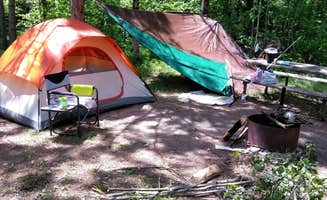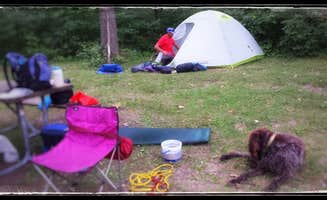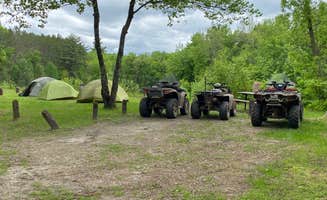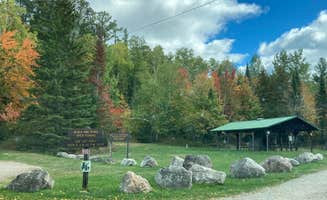Tent campers visiting Hibbing, Minnesota can choose from several rustic campgrounds along northern Minnesota's lakes and river systems. Campsites are typically available from late April through early October, though some remote locations may close earlier due to seasonal road conditions. Minnesota's iron range region receives approximately 28 inches of rainfall annually, with heaviest precipitation occurring in June and July when thunder storms are common.
What to do
Fishing and paddling: Lost Lake in George Washington State Forest provides a peaceful fishing experience with a convenient boat launch. "There is a nice lake with a convenient boat launch nearby, nicely spaced wooded campsites, room for RVs but no hookups," notes a reviewer at George Washington State Forest Lost Lake campground. Bass and northern pike are common catches in the area's lakes.
River exploration: The Mississippi River water trail passes through the region with designated campsites. "To date, this is the best campsite I've ever seen. No joke. My husband and I like to canoe, and this time, we were on the Mississippi for another adventure," writes a reviewer about Blackberry Campsite, a water-access-only location. The Mississippi River maps available from the Minnesota DNR mark river miles and access points.
ATV trail access: Some campgrounds serve as bases for ATV enthusiasts using the extensive trail networks. "We rode ATV to this site and it empty. Right on the river and we needed bug spray for sure. There is a nice spring fed water hose that was close enough to hear while falling a sleep," notes a visitor about Jacobson County Campground, located along Great River Road.
What campers like
Secluded lake access: Many tent campers appreciate the direct lakefront locations. "Nice campground with several lakeside sites. Has all the basics: table, firepit, water and pit toilets. Peaceful campground on a beautiful lake. Loons calling," shares a visitor about Thistledew Campground.
Group facilities: The group camp at McCarthy Beach State Park accommodates large parties. "The group campsite has a nice log building for group gatherings, plus plenty of space for tents to accommodate up to fifty people. A small camper or two could also fit, but there are no RV hookups here," explains a reviewer at Group Camp — McCarthy Beach State Park.
Wilderness immersion: Sites farther from main roads offer true seclusion. "This is a small, quiet state forest campground, off the beaten path from any direction. The main activities are quiet camping, and fishing," notes a camper about Lost Lake. Most visitors highlight the call of loons and minimal light pollution for stargazing as key wilderness attributes.
What you should know
Access challenges: Remote campgrounds may require navigation on rough roads. "There has been some fresh logging activity in the area so that does affect the scenicness of the woods nearby, as well as the quality of the access road if it is rainy," cautions a reviewer about Lost Lake in George Washington State Forest.
Limited facilities: Most tent sites offer only basic amenities. "Basic water, basic pit toilets, picnic tables and fire rings, no other amenities besides peace and quiet and fish ready for your hooks," explains the same Lost Lake reviewer. Many forest campgrounds lack shower facilities and cell service.
Watercraft landing conditions: Water access campsites can have challenging landings. At Blackberry Campsite, a camper notes: "You have to tie your kayak to the shore - it's quite muddy and there is no place to pull it up (without considerable effort)." Water levels fluctuate throughout the season, affecting landing conditions.
Tips for camping with families
Field access: Seek campgrounds with open play areas. "We were lucky enough to get the last 5 sites in the loop, and even though we weren't right on the lake, we were adjacent to a large mowed field area where we could play games and kids could run freely," writes a camper about Bear Lake Campground.
Swimming options: Several campgrounds offer designated swimming areas for families. Many tent campers bring water toys and inflatables during July and August when water temperatures reach their warmest levels. Water shoes are recommended at most swimming areas due to rocky lake bottoms.
Bug protection: Northern Minnesota's mosquito season peaks from June through August. Mosquito nets for dining areas prove valuable, especially during evening hours. Long-sleeved clothing treated with permethrin provides effective protection during early summer camping trips.
Tips from RVers
Limited hookups: Most forest campgrounds accommodate smaller RVs but without services. "NEW NAME: SANDY PINES. Couldn't find a spot on a Saturday night and this sweet lady had a beautiful spot with all hookups! On a beautiful lake and free beach and paddle boats," notes a reviewer at Sal's Campground, one of the few with full hookup options.
Site spacing: Campground layouts vary significantly in privacy levels. "Some sites that are closest to the river are close together but okay view. Vaulted toilet and recycling/dumpster close proximity," explains a visitor to Jacobson County Campground. RVers report better separation between sites at state forest campgrounds compared to county parks.
Water access: Most tent campgrounds near Hibbing require visitors to bring containers for potable water. Several campgrounds have seasonal water systems operating from May through September, though early spring and late fall campers should bring their own supply.





